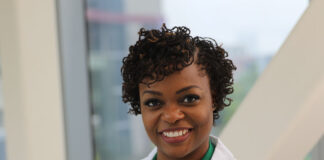October is Sudden Infant Death Syndrome (SIDS) awareness month and for the first time since 2016, the American Academy of Pediatrics (AAP) has released an updated set of recommendations for reducing infant sleep-related deaths.
Updated recommendations offer more specific action steps to take, primarily focus on highlighting protective factors for babies’ sleep environment, products to avoid, and practices that can reduce the risk of SIDS and SUID (Sudden Unexpected Infant Death).
SIDS is the sudden, unexpected death of a baby younger than one year of age that does not have a known cause even after a complete investigation. SUID covers all infant sleep-related deaths, including those for which there is an identified cause. (story continues below)
The AAP recommends infants sleep in their parents’ room, close to the parents’ bed, but on a separate surface designed for infants, ideally for at least the first six months.
This can be a crib, portable crib (pack n play), or bassinet (for the first five months) as long as it’s a firm, flat, non-inclined sleep surface to reduce the risk of suffocation or wedging/entrapment. Babies should only sleep wearing a onesie and wearable blanket (sleep sack) without anything else in the sleep space such as blankets, loose sheets, pillows and toys.
“New parents are getting information from grandparents, social media, and their doctor,” said James Craig, the OSDH Infant Safe Sleep Coordinator. “We want to make sure they have the most accurate and up-to-date information. Using the ABCs acronym is an easy way to remember the basics. Babies should sleep Alone, on their Backs, in an appropriate Crib, and in a tobacco/vape free home. Following these simple guidelines will help reduce the risk of SIDS-related deaths.”
Of note, the AAP, for the first time, has also deemed weighted products such as sleep sacks, swaddles, sleepers, and blankets, integrated with weights and marketed to help babies sleep deeper, unsafe to use. The AAP also warns against using cardiorespiratory monitors, such as monitors placed and worn on an infant’s foot, marketed to track your baby’s breathing due to limited evaluation for safety, accuracy, or efficacy by the FDA as other medical devices are.
“The AAP also mentions concerns those type of monitors could falsely reassure parents that an ailing baby is healthy, or alarm parents that a healthy baby is sick,” said Craig.
For more information on safe sleep visit Safe Sleep For Your Baby (oklahoma.gov) or email James Craig at [email protected].
The Oklahoma State Department of Health (OSDH) protects and improves public health through its system of local health services and strategies focused on preventing disease. OSDH provides technical support and guidance to 68 county health departments in Oklahoma, as well as guidance and consultation to the two independent city-county health departments in Oklahoma City and Tulsa. Learn more at Oklahoma.gov/health.













